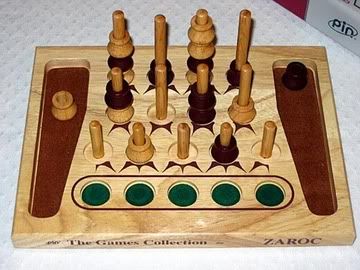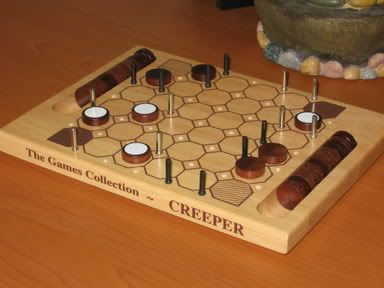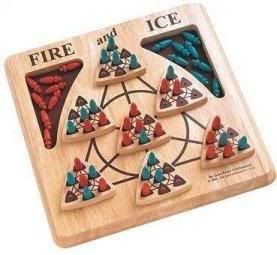I contacted Dale through Boardgamegeek prior to my trip. He offered to meet up with me and play some games. Sure enough, a call to his mobile phone and Dale said he'd meet me in my hotel's lobby to play.
As an aside, there is no place to get Eurogames in Thailand. Even PIN's abstract games which are manufactured in Thailand are not sold in the country. In light of that I guess I shouldn't feel so bad about Manila's dearth of game shops - at least one can purchase the likes of Die Siedler and Carcassonne off the shelf here, albeit at a painful premium. BGG member Michel "pixyfrog" Dauget had just relocated to Bangkok and was planning to open a game cafe sometime in 2006. I hope to visit next trip down.
Dale was carrying two of PIN's abstract games with him. One was a game I expressed interest in seeing - an unusual number that went by the name Zaroc. The other was a game called Creeper.
We chatted about the abstract game scene while Dale demolished me at Zaroc. This little niche of the gaming world has its own quirks. What stood out for me was the stigma of an abstract game being labelled as "broken" or "solvable" which carry far more weight than they do in the Eurogame world. Lacking a theme, mechanisms are the only thing that an abstract can fall back on. If the mechanisms don't work, then the game is usually toast. If it wasn't an abstract, you could bathe the game in artwork and stick shovelfuls of plastic minis into the box and people would buy the game just for the look.

Pic by Geoman, "borrowed" off the Geek
Anyway, about Zaroc - this is a counterintuitive movement game where you're trying to get three of your pieces into the five-slot "bottom" row of the board. Your pieces are skewered on pylons which get shorter as you go "down" the board. The counterintuitive element is in the movement. You can only move your piece "downstream" if it occupies the very top spot on a skewer, and even then it can only move into the adjacent downstream pegs. Otherwise all your piece can do is move sideways; it cannot move backwards. The rule that threw me though was the one where you couldn't "undo" the last move your opponent made (each player gets two moves on his turn). Zaroc is a short game, and it's not really complicated, but it certainly requires a bit of thinking.
The next interesting series of stories Dale related was about the abstract game industry, in which his PIN International competes against the likes of Gigamic. I won't go into details so as not to get Dale into trouble, but suffice to say that there are interesting rivalries and relationships between the companies and the game designers even in the niche world of abstract games.
The next game Dale showed me was Creeper. Now this was a more straighforward game and I wrapped my head around it much faster than I did with Zaroc. The object of the game is connect two corners of the rectangular board with markers. The markers are placed with metal pins that slot in between the hexagonal board spaces. When the pin hops over an empty space, it leaves a marker of its color on that space. If there's a piece in the space the pin jumps, it flips the piece (a-la Othello and YINSH). If it moves along the edge of the space and over an opposing pin, the pin is captured.
Dale still smoked me twice in a row, but at least I didn't embarass myself too badly.

After a second game of Zaroc, Dale said he had time for one more game and would I like to see Fire and Ice? There was no way I'd pass up playing a new game, so he went to grab the game from his car.
Fire and Ice, as Dale tells it, is a game of symmetry. This explains the unusual board layout. Players take turns placing colored pins (red and blue, hence Fire and Ice) onto the board. The game starts with just a single red peg in the center slot of the center isle. The start (fire) player now has to move that peg, either to any open slot on the same isle, or to the same exact slot on a different isle. The catch? You place a peg of the opponent's color in the spot that your peg just vacated. The object of the game is to control three island in a row, or in a ring (see the pic of the board). You achieve control of an isle if you have three pegs in a row or in a ring on that isle.
The fun part is that the game is expandable in iterations. You can play on seven boards, thus expanding the game into controlling three isles in a row or ring on three boards in a row or ring to win. And then you can play on seven sets of seven boards if you really have a lot of time on your hands. Or you want to go insane.

Pic by Pergioco, "borrowed" off the Geek
Dale had to go after killing me at Fire and Ice. Before leaving, he generously gifted me with the copy of Creeper that we had played on. Thanks Dale! It was a nice afternoon of coffee and games, and I was very happy that I got a chance to meet another gamer in Asia.
1 comment:
Thanks for the information.
Post a Comment